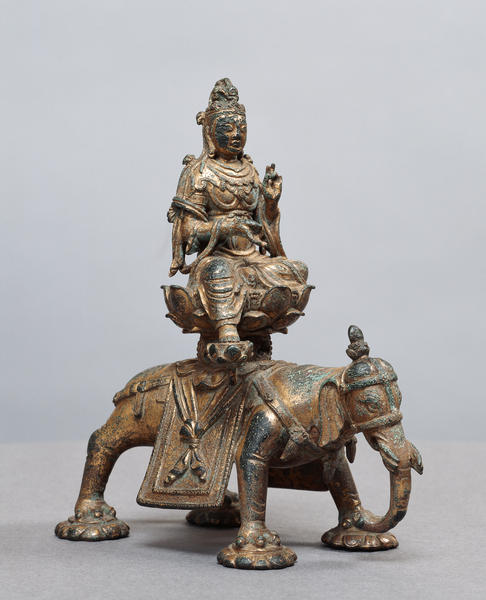普賢菩薩像
- 中国 遼時代
- 10-12c
- 青銅鍍金
- 所蔵
- 浜松市美術館
普賢菩薩は頭に宝冠を戴き、重厚な上半身を瓔珞で飾る。右手は肘を曲げて前に出し、掌を向け、第一指と第四指を念ずる。一方、左手は胸部の高さまで掌を立てて、第一指と第四指を念ずる。蓮華座の上に半跏し、下ろした右足を小さな蓮華が支える。蓮華座の蓮弁も重厚で、反花はしっかりと象の背中にのる。象は六牙を有し、四肢をそれぞれ蓮華の上にのせる。象の頭部には宝珠型の装飾を着ける。ただし象の体格は実物とかけ離れ、あたかも重さに耐えかねたようにつぶれて脚が短く、爬虫類のようなユーモラスな姿に表される。普賢菩薩は大乗仏教の菩薩の中でもとくに重要な菩薩とされ、鳩摩羅什訳『妙法蓮華経』「普賢菩薩勧発品第二十八」によれば、六牙の白象に乗って出現し仏教の教化にあたるという。騎象の普賢菩薩は、青獅子に乗った文殊菩薩と一対で、釈迦の脇侍として表す作例が多い。本作例も象の顔の向きから、三尊像の右脇侍であった可能性も考えられる。
Catalogue Entry
This image of the Samantabhadra wears a crown, the heavy upper part of his body adorned with hanging ornaments. His right elbow bent, he holds out his right hand, palm facing up. His left hand is held up at chest level, palm facing out. Both hands join the tips of the thumb and ring fingers, representing his concentration on prayer. Fugen sits on the lotus pedestal in the half-lotus position, right leg extended downward and foot resting on a small lotus. The lotus pedestal has thick and large upturned petals and the downturned petals and base are firmly affixed to the back of the elephant.
The elephant has six tusks and its four legs stand on lotus flowers. Its head is decorated with a hoju (onion-shaped decorative jewel)-like object. Disproportionately smaller than its rider, the elephant labors under its heavy load, and the foreshortening of its legs give it a humorous, almost reptile-like appearance.
Fugen is regarded as especially important among the bodhisattvas in Mahayana Buddhism. According to “Fugen Bosatsu Kanbotsu” [The Encouragements of Bodhisattva Fugen], 28th chapter of Kumarajiva’s Chinese translation in 406 of the Lotus Sutra, Fugen travels on a six-tusked elephant in spreading Buddhism.
There are many cases of sculpture in which Fugen on an elephant is paired with Manjushiri Bodhisattva riding on a blue lion in attendance on Sakyamuni. The present work, judging from the direction of the elephant’s face, was possibly the attendant of a triad, positioned on the right side of Sakyamuni.
